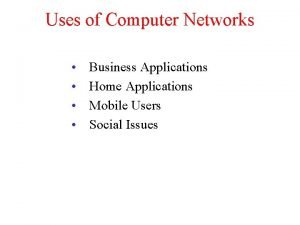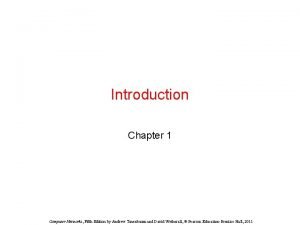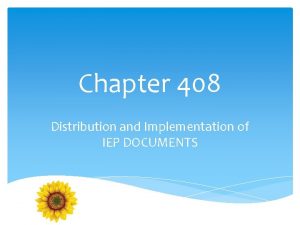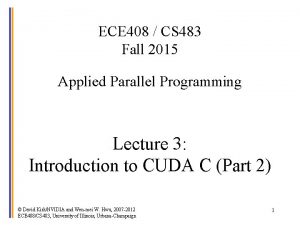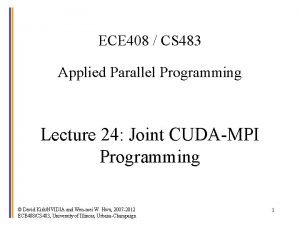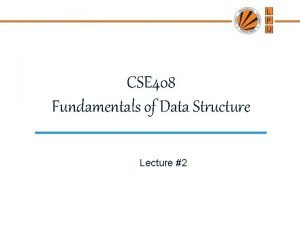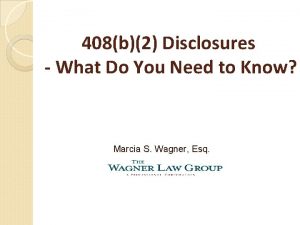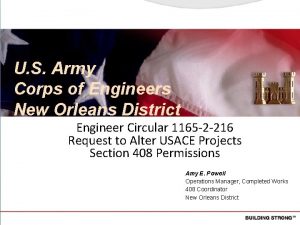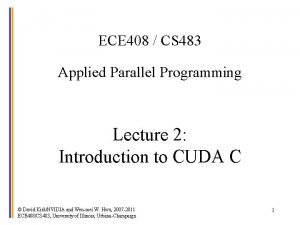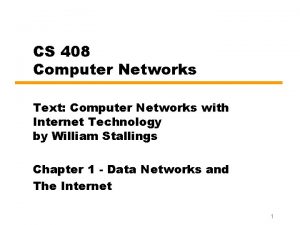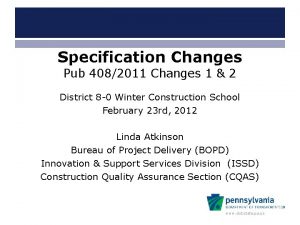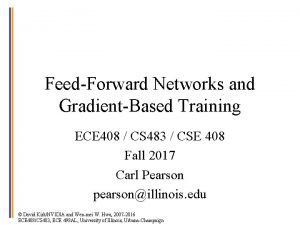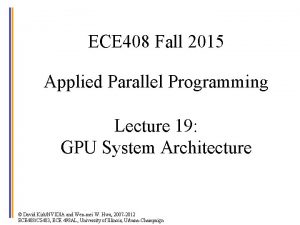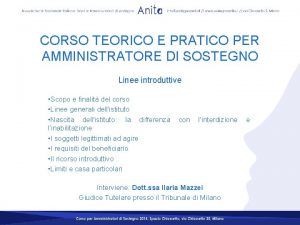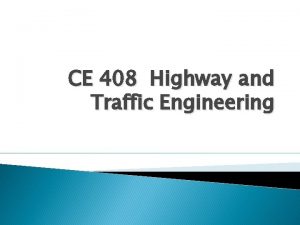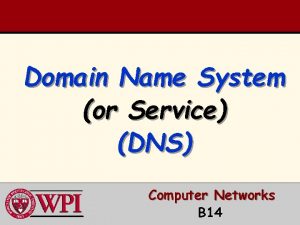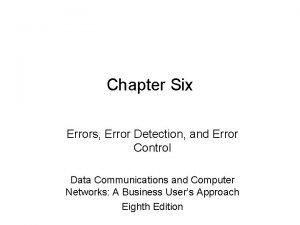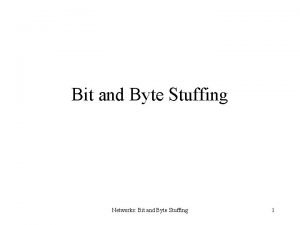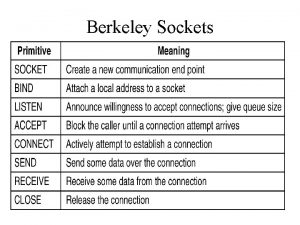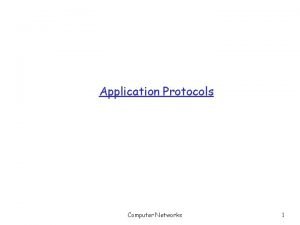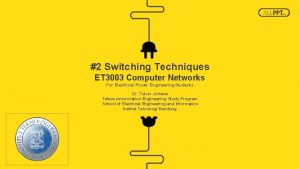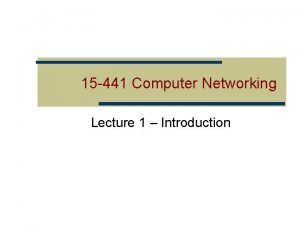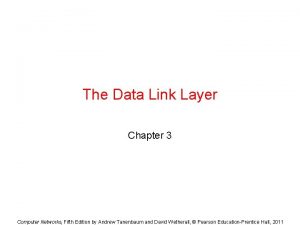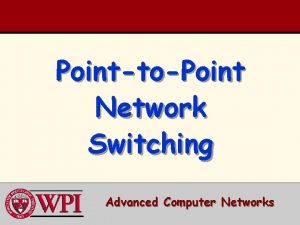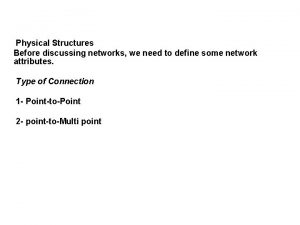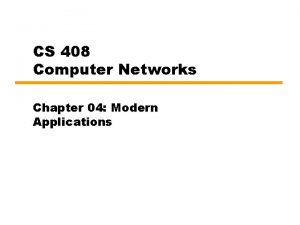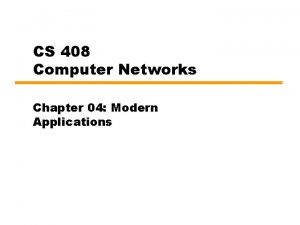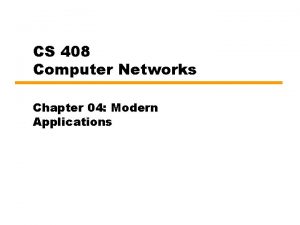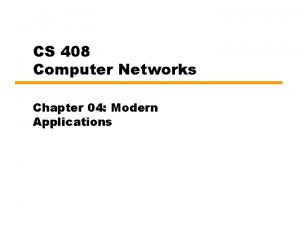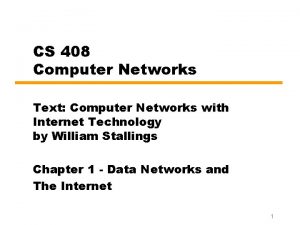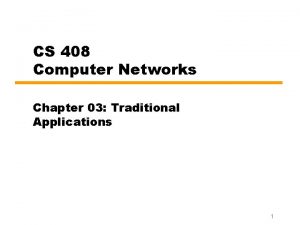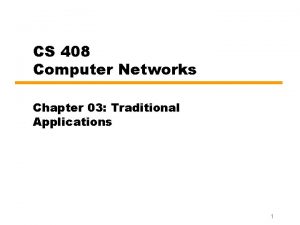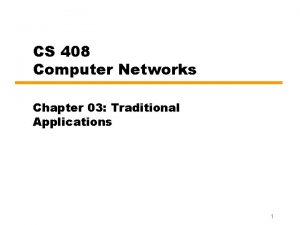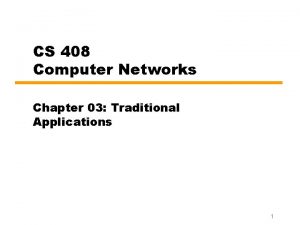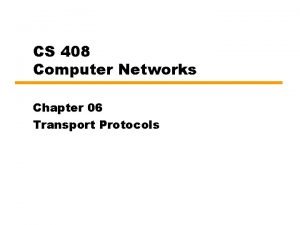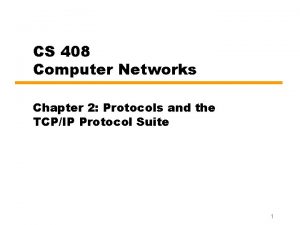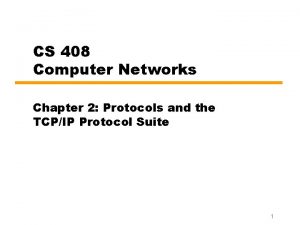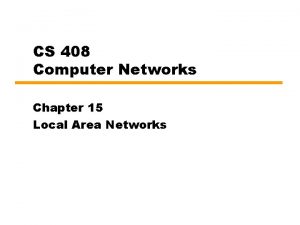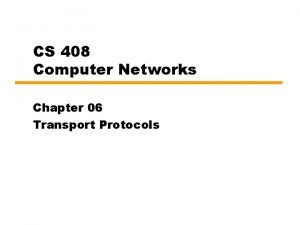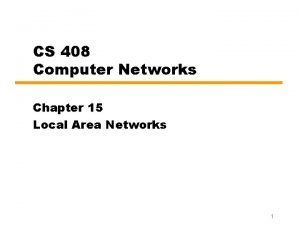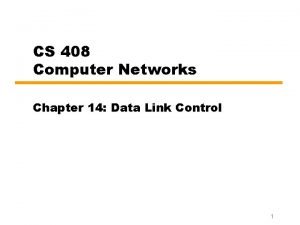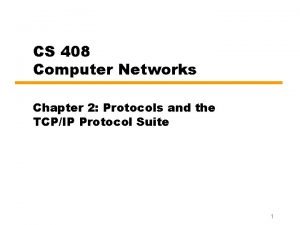CS 408 Computer Networks Chapter 04 Modern Applications
























































- Slides: 56

CS 408 Computer Networks Chapter 04: Modern Applications

Hypertext Transfer Protocol HTTP • What does hypertext mean? “a body of written or pictorial material interconnected in such a complex way that it could not conveniently be presented or represented on paper” Ted Nelson, 1965 • Underlying protocol of the World Wide Web • Can transfer plain text, audio, images, etc. — actually you can transfer any type of file using HTTP • Most recent version HTTP 1. 1 – RFC 2616 — 176 pages

HTTP Overview • • Transaction oriented client/server protocol Usually between Web browser (client) and Web server Uses TCP connections (on port 80) Stateless — Server (normally) does not keep any info about client history — Each transaction treated independently — New TCP connection for each transaction — Terminate connection when transaction is complete — That does not mean that, say, 20 new connections are needed to download 20 different items from a web site. • It is possible to have “persistent” connections that several items are downloaded back-to-back • Why stateless? — any idea? — Hint: it was a design decision due to the nature of transactions

Examples of HTTP Operation end-to-end direct connection intermediate nodes such as proxy use of cache

HTTP Messages • Simple request/response mechanism • Requests —Client to server • Responses —Server to client

HTTP Message Structure Response(status) Line /

Request • Request-Line Method <SP> Request_URL <SP> HTTP/Version <CRLF> • Several Methods - some examples —Get —Head —Delete —Put • Example GET /index. html HTTP/1. 1

General Header Fields • Contain information that is not directly related to data to be transferred — but mostly directives to intermediate nodes

Request Header Field • Additional parameters about requests - some examples —Accept charset —Accept language —Host —If modified since • Useful with GET command —Referrer

Response Messages • Status line followed by one or more general, response and entity headers, followed by optional entity body • Status-Line = HTTP-Version <SP> Status-Code <SP> Reason-Phrase <CRLF> —some examples for status-code – reason-phrase pairs • • 200 OK 404 Not found 405 Method not allowed 400 Bad request

Response Header Fields • Additional info about the response • Some examples —Location: exact location of the requested URL —Server: info about server software

Entity Header • Information about the entity —similar to MIME format • Some examples —Content language —Content length —Content type —Last modified —etc.

Entity Body • Arbitrary sequence of octets that constitutes the transferred entity (actual data) • HTTP transfers any type of data including: —text —binary data —audio —images —video • Interpretation of data determined by header fields

The rest of HTTP discussion is from Kurose&Ross HTTP request message • ASCII (human-readable format) • Example: request line (GET, PUT, HEAD, etc. commands) GET /somedir/page. html HTTP/1. 1 Host: www. someschool. edu User-agent: Mozilla/4. 0 header Connection: close lines Accept-language: fr Carriage return, line feed indicates end of message (extra carriage return, line feed) First open a connection (telnet) to a host at port 80

HTTP response message (example) status line (protocol status code status phrase) header lines data, e. g. , requested HTML file HTTP/1. 1 200 OK Connection close Date: Thu, 06 Aug 1998 12: 00: 15 GMT Server: Apache/1. 3. 0 (Unix) Last-Modified: Mon, 22 Jun 1998 …. . . Content-Length: 6821 Content-Type: text/html data data. . .

HTTP connections Nonpersistent HTTP Persistent HTTP • At most one object is sent • Multiple objects can be over a TCP connection. sent over single TCP connection between client • HTTP/1. 0 uses and server. nonpersistent HTTP • HTTP/1. 1 uses persistent connections in default mode (however, it is still possible to have nonpersistent connections in HTTP/1. 1)

Nonpersistent HTTP (contains text, references to 10 www. some. School. edu/some. Department/home. index jpeg images) Suppose user enters URL 1 a. HTTP client initiates TCP connection to HTTP server (process) at www. some. School. edu on port 80 2. HTTP client sends HTTP request message (containing URL) into TCP connection socket. Message indicates that client wants object some. Department/home. index time 1 b. HTTP server at host www. some. School. edu waiting for TCP connection at port 80. “accepts” connection, notifying client 3. HTTP server receives request message, forms response message containing requested object, and sends message into its socket

Nonpersistent HTTP (cont. ) 5. HTTP client receives response message containing html file, displays html. Parsing html file, finds 10 referenced jpeg objects time 6. Steps 1 -5 repeated for each of 10 jpeg objects 4. HTTP server closes TCP connection.

Response time modeling Definition of RRT (round trip time): time to send a small packet to travel from client to server and initiate TCP connection back. RTT Response time: request • one RTT to initiate TCP file connection RTT • one RTT for HTTP request file and first few bytes of received HTTP response to return • file transmission time total = 2 RTT+transmit time to transmit file time

Persistent HTTP Nonpersistent HTTP issues: • requires 2 RTTs per object • but browsers often open parallel TCP connections to fetch referenced objects • Client and server should allocate resources for each TCP connection Persistent HTTP • server leaves connection open after sending response • subsequent HTTP messages between same client/server are sent over connection Persistent without pipelining: • client issues new request only when previous response has been received • one RTT for each referenced object Persistent with pipelining: • default in HTTP/1. 1 • client sends requests as soon as it encounters a referenced object • as little as one RTT for all the referenced objects

Cookies: keeping “state” Many major Web sites use cookies to remember their clients Four components: 1) cookie header line in the HTTP response message 2) cookie header line in HTTP request message 3) cookie file kept on user’s host and managed by user’s browser 4) back-end database at Web site Example: — Susan access Internet always from same PC — She visits a specific ecommerce site for first time — When initial HTTP requests arrives at site, site creates a unique ID and creates an entry in backend database for ID — One week later, when Susan visits the same site, the site remembers her this part is adapted from Kurose&Ross, Computer Networking

Cookies: keeping “state” (cont. ) client Cookie file ebay: 8734 Server (amazon) usual http request msg usual http response + Set-cookie: 1678 Cookie file e n server da try i tab n b creates ID as ac e ke nd 1678 for user ss amazon: 1678 ebay: 8734 Cookie file amazon: 1678 ebay: 8734 ac ce one week later: usual http request msg cookie: 1678 usual http response msg cookiespectific action

Cookies (continued) What cookies can bring: • Identification • Customization • Shopping carts • User session state (server remembers where client stopped last time) Cookies and privacy: • cookies permit sites to learn a lot about you — and may sell this info • advertising companies obtain info across sites about your browsing pattern using banner ads that contain cookies

Internet Directory Services DNS • Domain Name System —a directory lookup service —Provides mapping between host name and IP address —A “must” for proper to functioning of Internet • RFCs 1034 (concepts) and 1035 (implementation) — 1987 —total 110 pages

Internet Directory Services DNS • Four important elements of DNS —Domain name space • Tree-structured —DNS database (distributed) • The info about each node in name space tree structure is contained in a Resource Record (RR). • The collection of RRs is organized as a distributed database —Name servers • Servers that hold and process information about portion of tree and corresponding RRs —Name Resolvers • Programs that help clients to extract information from name servers

Domain Names • 32 -bit IPv 4 addresses uniquely identify devices — Network number, Host address, later subnet addresses — Routers route based on network numbers • People tend to memorize names, not numbers — a naming mechanism is needed • In Arpanet times, hosts. txt file was used — managed centrally, downloaded by all hosts daily — become insufficient in time • In the Internet, naming problem is addressed by concept of domain — Group of hosts that are under control of single entity — Organized hierarchically — Names assigned reflect organization

Portion of Internet Domain Tree Top level domains • over 200 TLDs (including newly added ones, e. g. . biz. pro • hierarchy helps uniqueness (explain this in CS terms!) • Do you know the char length limits? • Naming follows organizational boundaries, not physical ones

Domain Name Example • edu is college-level educational institutions • yale. edu is Domain for Yale University in US —should yale. edu have an IP address? —not necessary, but it has (130. 132. 59. 127) • cs. yale. edu is Computer Science department at Yale —has an IP address (128. 36. 229. 30) • Eventually get to leaf nodes —Identify specific hosts —Hosts assigned Internet (IP) addresses

DNS Database • Variable-depth unlimited levels hierarchy for names —Delimited by period (. ) • Distributed database —Thousands of zones —each of these zones are separately managed by different name servers • Each TLD and subordinate nodes manage uniqueness of the names assigned —Delegated down the hierarchy

Zones • Each non-leaf node may or may not manage its childs — cs. yale. edu would like to run its own name server, but eng. yale. edu not • Next: How can we represent a zone in the database? — but before, we have to understand the structure of resource records

Resource Record - 1 • Records in a DNS database are called Resource Records (RRs) —info about hosts —different types • Fields of one RR Name TTL Class Type Value —Domain name • Series of labels of alphanumeric characters or hyphens • Each pair separated by period —Type • of the RR. We will see now

Resource Record - 2 • RR Fields (cont’d) —Class • Potentially DNS can be used for naming in several other systems • Usually IN, for Internet —Time to live (TTL) • How long to hold the result in local cache • Zero means don’t cache —Value (Rdata) • Description of resource • For A type, Rdata is 32 -bit IP address

Resource Record Types - 1 • A —Address type. Value of A type RRs is an IP address • SOA —Start of Authority —Parameters (mostly to sync with other servers) and info about this zone • MX —Mail Exchange —name of the receiving SMTP agent for the zone —may be more than one MX RRs for one zone • priorities are used

Resource Record Types - 2 • CNAME —Canonical Name —used to create aliases —value is the canonical host name • NS —Name Server —Value field is the name of the server who knows the IP addresses of the hosts that belongs to the domain given in the Domain_Name field. —can be used to specify the names of the name servers in both current domain or in subordinate domains (for delegation purposes) • There might be several DNS servers for each domain for fault tolerance

Resource Record Types - 3 • PTR —Pointer type —mostly used for reverse lookups —Domain_Name field is an IP address; Value is the hostname • HINFO —Host Info. —OS and processor type of information about the zone’s server • TXT —Textual comments

A portion of a possible DNS database for cs. vu. nl. 86400 IN NS flits. cs. vu. nl. star. cs. vu. nl.

Addition to previous example • How to delegate a subzone ai. cs. vu. nl? • Add the following RRs to database for cs. vu. nl ai. cs. vu. nl. 86400 IN NS dns. ai. cs. vu. nl. 86400 IN A 130. 37. 56. 350 ; IP address of dns. ai. cs. vu. nl ; this is called as “glue record”

A Better Example of SOA RR anynet. com IN SOA dns. anynet. com. admin. anynet. com ( 2004041401 ; Serial Admin’s 3600 ; Refresh email 300 ; Retry address 3600000 ; Expire 86400) ; Minimum Host name of the primary name server o the zone

The mystery behind different IPs for the same host • For load balancing —Works in round-robin fashion albertlevi. com. 60 60 60 IN IN IN A A A 192. 1. 1. 1 192. 1. 1. 2 192. 1. 1. 3 • First query returns 192. 1. 1. 1, second query returns 192. 1. 1. 2, third returns 192. 1. 1. 3, forth 192. 1. 1. 1, . . . • Or one query returns all IP addresses, but in different order in every other query

Example for PTR record for Reverse Lookup • Useful when you know the IP address and want to know the corresponding host name • Suppose you would like to know the host name for IP address 193. 140. 192. 24 —you have to query the DNS servers for the PTR entry 24. 192. 140. 193. in-addr. arpa. — Be careful! numbers are in reverse order — In order to find the host name, the host’s name server should have an entry 24. 192. 140. 193. in-addr. arpa. PTR domain_name — for this particular case domain_name is kennedy. cc. boun. edu. tr

Reverse DNS for 193. 140. 192. 24 Generated by www. DNSstuff. com Preparation: The reverse DNS entry for an IP is found by reversing the IP, adding it to "in-addr. arpa", and looking up the PTR record. So, the reverse DNS entry for 193. 140. 192. 24 is found by looking up the PTR record for 24. 192. 140. 193. in-addr. arpa. All DNS requests start by asking the root servers, and they let us know what to do next. How I am searching: Asking b. root-servers. net for 24. 192. 140. 193. in-addr. arpa PTR record: b. root-servers. net says to go to sec 3. apnic. net. (zone: 193. in-addr. arpa. ) Asking sec 3. apnic. net. for 24. 192. 140. 193. in-addr. arpa PTR record: sec 3. apnic. net says to go to efe. ulakbim. gov. tr. (zone: 140. 193. inaddr. arpa. ) Asking efe. ulakbim. gov. tr. for 24. 192. 140. 193. in-addr. arpa PTR record: efe. ulakbim. gov. tr says to go to foca. cc. boun. edu. tr. (zone: 192. 140. 193. in-addr. arpa. ) Asking foca. cc. boun. edu. tr. for 24. 192. 140. 193. in-addr. arpa PTR record: Reports kennedy. cc. boun. edu. tr. Answer: 193. 140. 192. 24 PTR record: kennedy. cc. boun. edu. tr. [TTL 3600 s] [A=193. 140. 192. 24]

Typical DNS Operation • User program requests IP address for a domain name • Resolver module in local host formulates query for local name server — In same domain as resolver • Local name server checks for name in local database or cache — If so, returns IP address to requestor — Otherwise, query other available name servers • Starting down from root of DNS tree • Local name server caches the reply — and maintain it for TTL seconds • User program is given IP address or error message

DNS Name Resolution local

Root Name Servers • servers for TLDs • local server starts with a root server if it does not know anything about the domain to be resolved —actually there a dozen of them worldwide —listed in configuration files of the name servers Figure from Kurose-Ross

Authoritative Name Servers • A relative concept — the authoritative name server of a host is the one that keeps the A type RR of that host • Actually a local name server is also authoritative name server for the hosts in that domain • In principle, DNS queries aim to reach the authoritative name server for the host to be resolved — but generally responses come from the other servers that already cached the requested record • that is why the nslookup responses are mostly non-authoritative • DNS name servers automatically send out updates to other relevant name servers for quick response — mechanisms designed in RFC 2136 and not in the scope of CS 408

Iterative vs. Recursive Queries • Recursive —If one name server does not know the queried host, it acts like a DNS client and asks to another name server. —Then send the result back • Iterative —in the name server does not know the host, then returns the address of the next server, but does not ask that server. • Examples coming • Remark: Queries and responses are sent over UDP (mostly) —Why?

Example - 1 • looking for the IP address of gaia. cs. umass. edu • Recursive queries • Let’s think about cached alternatives

Example - 2 • looking for the IP address of gaia. cs. umass. edu • Recursive and iterative queries

DNS Message Format

DNS Message Fields - Header • Header always present — Identifier to match queries and responses. — Query / Response: is message query or response? — Opcode: Standard, inverse query (address to name), or server status request — Authoritative Answer: is the response authoritative? — Truncated: was response truncated • Requestor will use TCP to resend query — Recursion Desired — Recursion Available — Response Code: e. g. no error, format error, name does not exist — QDcount: # of entries in question section (zero or more) — ANcount: # of RRs in answer section (zero or more) — NScount: # of RRs in authority section (zero or more) — ARcount: # of RRs in additional records section (zero or more)

DNS Message Fields – Question and Answers • Domain Name —Sequence of labels for the domain name to be resolved • Query Type —what type of RR is requested? • Query Class: typically Internet. • Answer section contains RRs that answer question • Authority section contains RRs that point toward an authoritative name server

Sockets • 1980 s UNIX Berkeley Sockets Interface • Socket enables communications between client and server process • Connection-oriented or connectionless • Endpoint in communication • Client socket in one computer uses address to call server socket on another computer • Once appropriate sockets engaged, can exchange data • Server sockets keep TCP or UDP port open • Once connected server switches dialogue to different port

Sockets API (1) • Sockets can be constructed from within program in most languages • Berkeley Sockets Interface is de facto standard API — Windows Sockets (Win. Sock) based on Berkeley • TCP and UDP header includes source port and destination port fields — Identify respective users (applications) • IPv 4 and IPv 6 header includes source address and destination address fields — Identify host systems • Port value with IP address forms socket — Unique throughout Internet • When used as API, socket is identified by triple — Protocol, local-address (IP), local-process (port)

Sockets API • Sockets API recognizes three types of sockets —Stream sockets for TCP, connection-oriented reliable —Datagram sockets for UDP, connectionless —Raw sockets • Direct access to lower layer protocols, e. g. IP and ICMP

Socket Interface Calls • • Gethostname Gethostbyname Setup Connect —Client • Listen/accept —Server • Send • Receive • Close

Figure 4. 13 Socket System Calls for Connection-Oriented Protocol
 Difference between datagram and virtual circuit operation
Difference between datagram and virtual circuit operation Backbone networks in computer networks
Backbone networks in computer networks Uses of computer network
Uses of computer network Principles of network applications in computer networks
Principles of network applications in computer networks Computer networks and internets with internet applications
Computer networks and internets with internet applications Business application in computer network
Business application in computer network Business applications of computer networks
Business applications of computer networks Chapter 408
Chapter 408 Uiuc cs 483
Uiuc cs 483 Cs 483
Cs 483 Cse408
Cse408 Erisa 408(b)(2) disclosure sample
Erisa 408(b)(2) disclosure sample Usace section 408
Usace section 408 Ece 408
Ece 408 Cs 408 sabancı
Cs 408 sabancı Pub 408
Pub 408 Ece 408
Ece 408 Ece 408
Ece 408 Amministratore di sostegno lite tra fratelli
Amministratore di sostegno lite tra fratelli Map study in highway engineering
Map study in highway engineering Crc in computer networks
Crc in computer networks Crc in computer networks
Crc in computer networks Traffic management in computer networks
Traffic management in computer networks Tanenbaum
Tanenbaum What is optimality principle in computer networks
What is optimality principle in computer networks Snmp ports
Snmp ports What is optimality principle in computer networks
What is optimality principle in computer networks Classify computer networks based of transmission technology
Classify computer networks based of transmission technology Dns in computer networks
Dns in computer networks Diffserv vs intserv
Diffserv vs intserv Icmp in computer networks
Icmp in computer networks Web and http in computer networks
Web and http in computer networks Framing in computer network
Framing in computer network Dns in computer networks
Dns in computer networks Data communication assignment
Data communication assignment Distributed systems vs computer networks
Distributed systems vs computer networks Algorithms in computer networks
Algorithms in computer networks Error detection computer networks
Error detection computer networks Error detection and correction in computer networks
Error detection and correction in computer networks Internet transport protocol in computer networks
Internet transport protocol in computer networks Error control in computer networks
Error control in computer networks Subnet
Subnet Data link layer switching in computer networks
Data link layer switching in computer networks Layered task
Layered task Bit stuffing in hdlc
Bit stuffing in hdlc Byte stuffing example
Byte stuffing example Bit bayt
Bit bayt Berkeley socket primitives
Berkeley socket primitives Rarp cisco
Rarp cisco Ftp protocol in computer networks
Ftp protocol in computer networks Switching techniques in computer networks
Switching techniques in computer networks Cmu 15-441
Cmu 15-441 Utopian simplex protocol in computer networks
Utopian simplex protocol in computer networks Sonet network
Sonet network Cell switching in computer networks
Cell switching in computer networks Physical structures in computer networks
Physical structures in computer networks Presentation layer in computer networks
Presentation layer in computer networks





